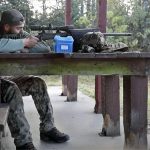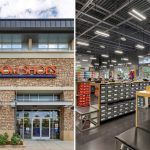Many indicators, including a record-setting 2011, show the firearms industry continues to thrive in a down economy and that the potential exists for another strong sales year in 2012, reports the National Shooting Sports Foundation®, the trade association for the firearms, ammunition, hunting and shooting sports industry.
NSSF® made the announcement today at the Shooting, Hunting and Outdoor Trade ShowSM (SHOT Show®), where exhibitors unveiled thousands of new products they hope will excite customers in 2012. The trade show, with an attendance of nearly 60,000, is the largest of its kind in the world.
The $4 billion firearms and ammunition industry stands apart from other industries that are struggling in the slow economy. Demand for guns has continued at a robust pace since late 2008. NSSF estimates the industry is responsible for approximately 180,000 jobs and has impact on the U.S. economy of $28 billion.
Indicators such as background-check statistics, firearms production and importation, firearm-retailer surveys and on-the-ground reports from retailers nationwide reveal that interest in firearm ownership is high. “More and more Americans are choosing to exercise their Second Amendment rights, and they are doing so in a safe and responsible manner,” said NSSF President and CEO Steve Sanetti.
Reports also suggest increased demand for concealed carry permits and for learn-to-shoot seminars such as NSSF's First Shots program. “We have seen a lot of first-time buyers in our store,” said Joe Keffer, owner of the Sportsman's Shop in New Holland, Pa. “People want information. They're interested in instruction.”
One of the best indicators of firearms sales is the FBI's National Instant Background Check System, which federally licensed firearm retailers use to conduct the mandatory background check on purchasers of new and used firearms. NSSF downwardly adjusts the NICS data by subtracting checks related to non-purchasing activity, such as checks for concealed carry permits, in order to gain a more accurate picture of market activity.
December marked an unprecedented 19th straight month of background check increases when compared to the same period in the previous year. NSSF-adjusted background checks for December totaled more than 1,410,937 (1,854,400 “unadjusted”)–the most ever for any single month. This comes on the heels of the historic “Black Friday” (Nov. 25, 2011) record for the most background checks in a single day – 129,166 – a 32 percent increase over the previous one-day high.
Another indicator pointing to robust gun sales is the federal excise taxes collected on the sale of new firearms and ammunition, which have risen 48.3 percent over the last five years.
Why are more Americans choosing to own firearms? Reasons range from citizens' increased awareness of the Second Amendment protecting the individual right to own firearms that was reaffirmed in two recent Supreme Court decisions, to increased interest in personal and home protection that may be due to economic uncertainty, to increased interest in the shooting sports and hunting.
Politics has played a role, too, with a surge in firearms sale beginning in October 2008, in part because supporters of the Second Amendment feared the election of less gun-friendly candidates, including Barack Obama, and new, restrictive gun laws they might advocate. Though such legislation has not happened, industry professionals at the SHOT Show believe a similar reaction this election year is possible that could ignite another surge in firearm sales.
Related to the topic of gun sales is the public's changing attitude toward ownership. A recent Gallop poll showed a record lack of support for gun control, with only 26 percent of Americans favoring a ban on the possession of handguns. When Gallup first asked Americans this question some 50 years ago, 60 percent favored banning handguns.
As sales climb, recent FBI data shows violent crime continuing to fall in the United States, with homicides dropping out of the top 15 causes of death in the country. The statistics undermine a favorite argument of anti-gun groups that “more guns equal more crime.”
“These statistics vividly demonstrate that the lawful possession and use of firearms by law-abiding Americans does not cause crime,” said Lawrence G. Keane, NSSF senior vice president and general counsel. “There have never been more firearms in civilian possession in the history of the United States, and crime, including homicide, continues to decline throughout the country.”
Whether they own firearms for target shooting, hunting, collecting or personal and home protection, Americans are enthusiastic and protective about guns they own. Several polls indicate Americans' high interest level for, and increased participation in, the shooting sports.
In 2010, an NSSF/Harris poll showed that 43 percent of respondents, which equates to nearly 98 million people, expressed some level of interest in participating in the shooting sports or hunting.
A 2010 NSSF/Responsive Management study showed that 15 percent of the U.S. population, representing 34.4 million people nationwide, went target shooting in 2009. This number surpassed all previous estimates of annual sport shooting participation. Among the most active participants are those who own a modern sporting rifle (MSR), a best-selling rifle type that is based on the popular AR platform and is the civilian, semiautomatic version of the military's M16. According to a 2011 NSSF survey, MSR owners go target shooting more often than individuals who own other types of firearms. Twenty-five percent of those surveyed said they shot 1,000 rounds of ammunition in the last 12 months with their MSRs.
As for hunting, the decades-long national decline in hunting license sales has ceased, and more than 20 states have reported increases in hunting licenses sold.
Women, in particular, seem eager to explore firearms ownership. Participation by women increased in both target shooting (46.5 percent) and hunting (36.6 percent) in the last decade, according to the National Association of Sporting Goods Wholesalers. Also, 61 percent of firearm retailers responding to an NSSF survey said they saw an increase in female customers in their stores.
More firearms in civilian possession neither equates to more crime nor to more accidents. NSSF points out that safe and responsible firearms ownership is the norm, not the exception. With an estimated 85 to 90 million firearms owners in the country, accidental firearms fatalities are at a historic low, a level that industry and other concerned groups are working to maintain through such programs as NSSF's Project ChildSafe, which provides free firearms safety kits to law enforcement agencies nationwide.














